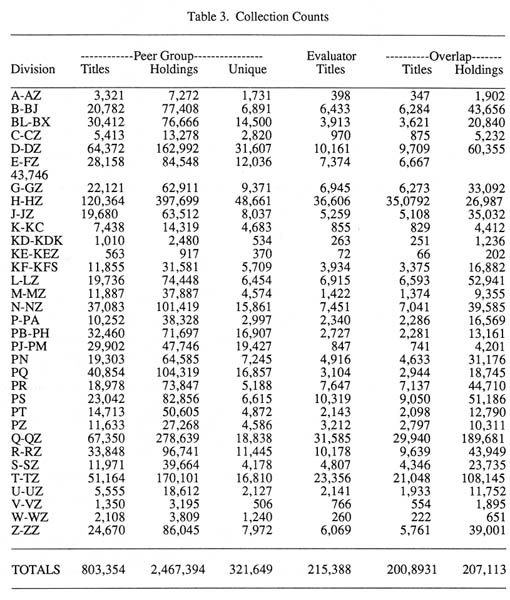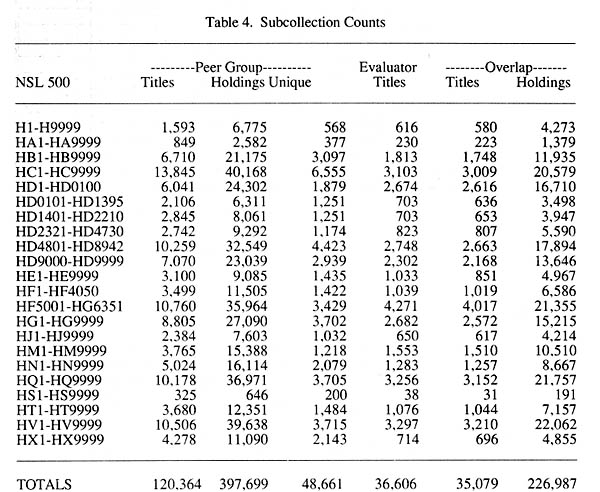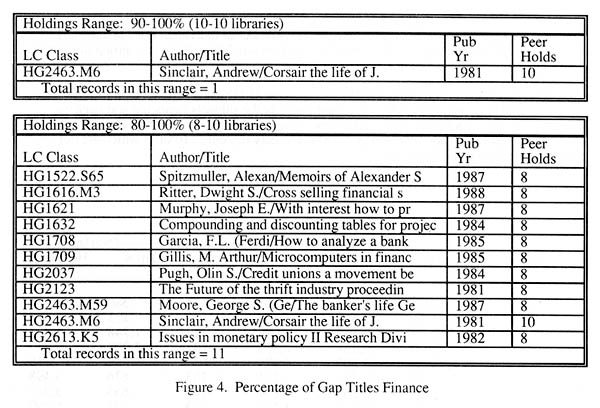
Suzanne D. Gyeszly, Charles R. Smith & Gary Allen
Sterling C. Evans Library
Texas A&M University
College Station, TX 77843, USA
Abstract: OCLC and AMIGOS Bibliographic Council, Inc., jointly developed a CD-ROM product in 1989 to provide assistance for librarians in automated collec-tion analysis. The CD-ROM has the capacity to compare a library collection in a particular subject area to an appropriate group or groups of institutions, to generate statistical data, and to provide a list of titles for strengthening retrospective collection in a targeted subject area.
Using the above features of the OCLC/AMIGOS Collection Analysis CD, a ques-tionnaire was sent to the academic department heads and departmental library representatives at the Texas A&M University in an effort to gather information related to current and projected curriculum and research directions. The forecasted areas of emphasis for each department were converted into Library of Congress call number ranges to be analyzed by the Collection Analysis CD. Once the strengths and weaknesses of the collection were determined, the results of the analysis were used to modify collection development policies, as well as generate lists of materials to fill the gaps. The study provides a model for libraries which plan to introduce automated collection development and management.
Analysis of library collections is very expensive, cumbersome, labor intensive, and time consuming. Collection development librarians sometimes neglect this activity because of the size of the collections, magnitude of the analysis, and lack of an automated method to analyze the entire library collection or any part of it. It was unthinkable until 1989 to try to compare library collections quantitatively and automationally against national standards or prominent institutions. Similarly it was very difficult to evaluate specific areas or an entire collection. However, with the cooperation of OCLC and AMIGOS Bibliographic Council, Inc., it became a reality with the new product called OCLC/AMIGOS Collection Analysis CD.
2. DESCRIPTION OF THE CD
The Collection Analysis CD allows the user to compare the participating libraries' hold- ings that are entered into the OCLC Online Union Catalog against peer institutions. As shown in Table 1, there are 14 standard peer groups based on collection size and academic degree program.
In addition the user may define a 15th group based on its own specification.
Table 1. Standard OCLC/AMIGOS Collection Analysis of Fourteen Peer Groups
NAME NUMBER OF INSTITUTIONS• Association of Research Libraries (ARL)
- All ARL member in OCLC 72
- ARL libraries 1st quartile (largest) 17
- ARL libraries 2nd quartile (next largest) 18
• Academic libraries with 700,000+ volumes
- Large academic libraries 86
- Collections with 1 million volumes 37
- Collections with 700,000-999,999 volumes 49
• Academic libraries with 300,000-699,999 volumes 209
- Supporting doctoral programs 67
- Supporting masters and bachelors programs 113
• All academic libraries with 100,000-299,999 volumes 473
- Supporting graduate degrees 266
- Supporting undergraduate degrees only 146
• All academic libraries with 50,000-99,999 volumes 134
• The entire 1.7 million record database 974
________________________________________________________________
The Collectrion Analysis CD has the following
product capabilities:
• Compares the user's library materials collection against national standards,larger institutions or smaller libraries
• Chooses broad or narrow subject definitions based on 32 subject divisions of the Library of Congress or the National Shelf List 500 classes
• Determines the strengths and weaknesses of the collections
• Produces customized bibliographies for acquisition
• Generates statistical reports
• Effectiveness of the library collection development policies
• Development of new courses and academic programs
• Change of acquisitions strategies
• Setting new priorities in collection development
• Justification for new fund allocations
2.1. Hardware
• OCLC M310 or M38 Workstation or IBM AT with:
- M310 or M386 or IBM enhanced keyboard
- minimum of 640K (RAM)
- 20-40 Hard-disk drive or greater depending on number of user-defined peer groups.
- one high density 5-1/4 inch floppy disk drive (1.2 MB)
- one Hitachi CD drive (model 1700, 2500, 3500 or 3600)
- printer (optional--Epson FX86E or equivalent parallel printer is recommended)
• MS-DOS CD-ROM Extensions 2.00 or greater
The database of the OCLC/AMIGOS Collection Analysis CD is extracted from the OCLC Online Union Catalog for mostly monographic titles (excluding serials, government docu-ments, and dissertations) published within a defined decade. The 1990 annual edition of the database includes titles published between 1978 and 1988 and it contains approximately 1.7 million abbreviated bibliographic records. Each record in the database must have a Library of Congress (LC) classification number and be held by at least one Association of Research Library (ARL) or academic library.
Figure 1 shows that each record contains author, title, publisher, year of publication, OCLC control number, and International Standard Book Number (ISBN). The records contain up to 100 characters of author/title information, of which 20 are extracted from MARC fields 100, 110, and 111, and the remaining ones are taken from MARC field 245. Since both holdings information and the comparative database were based on the OCLC Online Union Catalog, the Collection Development CD is available only to OCLC member institutions.
The Collection Analysis CD is available to purchase in two options:
One contains only the user's holdings data and the standard 14 peer groups'
data. The other has data of the user's holdings data, user's specified
peer group (up to 99 OCLC member institutions) and the standard 14 peer
groups' data.
The Banks and technology in the 1980s based on the seminar held at
Christ's College, Cambridge
Institute of Bankers, 1982
OCLC = 9763823
ISBN = 852970676
4. USE OF OCLC/AMIGOS COLLECTION ANALYSIS CD AT STERLING C. EVANS LIBRARY AT TEXAS A&M UNIVERSITY
The library purchased the Collection Analysis CD and the needed hardware in the spring of 1990. It allowed the collection development librarians to evaluate parts of the Sterling C. Evans Library collection and prepare for collection development at several levels. Comparison of the Sterling C. Evans Library with ten peer libraries, as shown in Table 2, could be made to measure collections.
Table 2. Ten Selected Peer Groups of the Sterling
C. Evans Library
______________________________________________________
University of Georgia
University of Illinois at Urbana-Champaign
Iowa State University
University of Minnesota-Twin Cities
Ohio State University
University of Oklahoma
Pennsylvania State University
Purdue University
Texas A&M University
Prior to the collection evaluation, the researcher sent a questionnaire to department heads and departmental library representatives in an attempt to gather information related to current and projected curriculum and research directions of the departments. The current and fore-casted areas of emphasis of each academic department were converted into Library of Congress call number ranges and were analyzed by the Collection Analysis CD.
An example of the current and projected curriculum and research, their matching Library of Congress Subject Headings, and their related LC classification numbers of the Department of Finance is listed in Figure 2:
| SUBJECT HEADINGS | CALL NO. | CODE |
| Agriculture-Finance | HD1437 | CC |
| Real Estate Business | HD251 | CR |
| Corporate Reorganizations | HD2741-46 | CR |
| Wages | HD58 | CR |
| Corporate Reorganizations | HD6977-7080 | CR |
| Wages | HD7091 | CR |
| Agricultural Industries | HD9000 | PC |
| Export Marketing | HF1009 | CR |
| Marketing | HF5415 | CC |
| Pensions | HG5601 | CR |
| Banks and Banking | HG1501-3542 | CC |
| Financial Institutions | HG153 | CC |
| Asset Management | HG1660 | CR |
| Financial Institutions | HG173-74 | CC |
| International Finance | HG3881 | CC |
| Corporation Finance | HG4001-4280 | CC |
| Portfolio Management | HG4529.5 | CR |
| Investors | HG4530 | CR |
| Options (Finance) | HG6024 | CC |
CODE: CC = Current Curriculum
PC = Projected Curriculum
CR = Current Research
PR = Projected Curriculum
Figure 2. Summary of Departmental Survey of the Department of Finance
The software allowed the use of the following main
menu: Collection metrics, subcollection metrics, and bibliographic lists.
The collection and subcollection metrics menu included: Counts, proportions,
overlap, holdings distribution, gap, and uniqueness. Sub-collection metrics
had the additional ability to view the more specific call number ranges.
The bibliographic list menu covered overlap, gap, unique evaluator and
peer groups, evaluator list, and peer group list. All bibliographic lists
could be saved in an ASCII file or printed out as needed. As can be seen
in Figure 3, the software also allowed the use of the established
| Set System Defaults | ||
| Peer Group: | 15 | TXA User Defined Peer Group |
| LC Division: | hg | H-HZ Social Sciences |
| NSL 500 Range | hg1501 | HG1-HG9999 Finance |
| LC Class Beginning:
Ending: |
hg1501
hg3550 |
This LC Class range contains 4177 record(s) |
| Holdings Pct Lower:
Upper: |
0
100 |
Items held by 0 - 100% of the peer group |
| Pub.Year Beginning:
Ending: |
1978
1988 |
Publication years 1978 to 1988 |
| Language: | ALL | All Languages |
| Output Device: | S | Enter S for Screen, P for printer |
| Save File Name: | A:\COLLANYL\STRATPLAN | |
Figure 3. Established parameters
parameters which were consistent throughout the entire project.
The analysis started with the general collection
counts where the basic call number ranges were adopted from the National
Shelf List Count. Table 3 shows the summary of the collection counts for
the entire collection.

It is important to note that the records contained on the Collection Analysis CD are only titles which were published during 1978-1988; therefore their numbers are much smaller than the total shelflist count of the Sterling C. Evans library and its selected ten peer groups. Table 4 includes three main groups:
1. Peer group (Selected ten institutions)
2. Evaluator (Sterling C. Evans Library's titles) and
3. Overlap (Overlap of titles between the Sterling C. Evans collection and the ten peer institutions).
The peer group heading is further divided into number of individual titles held by any member of peer group. The collective holdings are the cumulation of the peer group titles, and the unique titles were held by only one library.
The subcollection counts (Table 4) subdivides the H-HX call number ranges into further categories like HG1-HG9999, which represents mainly the subjects financing and banking. Evans Library has 2682 titles in the call number range, of which 2572 overlap with the ten selected peer groups. Therefore, Texas A&M University has only 110 titles which are not owned by the peer group libraries.

The Collection Analysis CD is also able to generate gap lists at different percentage levels, as shown in Figure 4, which help the librarians to prioritize materials for purchase.
Titles which were missing from the evaluator's institution
but found in 90 percent of the peer libraries generally were purchased
before materials found in 70 or 80 percent of peer libraries. Such comparison
made possible one method of refining and prioritizing collection needs.
In a time of tighter budget and greater users' demand, prioritizing is
indispensable.

The generated gap titles, such as those in Figure 5, were then used for retrospective collection development purposes.
5. CONCLUSION
The OCLC/AMIGOS Collection Analysis CD worked very well in making broad com-parisons with peer and other groups of libraries and in generating selective lists of acquisition possibilities of retrospective materials. However, raw data comparisons could not be fine tuned, and only the 1978-1988 decade of monographic publications were possible for com-parison. Therefore, making an evaluation of the entire library collection was impossible.
The new information provided by the Collection Analysis CD allowed collection develop-ment librarians to prioritize needs, to modify collection development policies, and to decide in which areas the library will excel in the future.
Hope, C.C. (Clarnec
The American Bankers Association, providing unity
and leadership to the banking
Newcomen Society in North America, 1980
OCLC = 7279455
Banking and investment in Saudi Arabia
Tihama 1981
OCLC = 9236667
International Banking
Competition & co operation in world banking.
Institute of Bankers, 1985
OCLC = 12657039
ISBN = 852971400
Affolter, Peter.
Aspekte des bankm assigen Hypothekargesch aftes
Probleme und osungsvorschl ag
P. Haupt, 1985
OCLC = 13350841
ISBN - 3258034737
REFERENCES
Dillon, Marin and Kevin Flash, "Design issues for microcomputer-based collection analysis system," Microcomputers for Information Management, 5 (4): 263-273 (December 1988).
Harrell, Jeanne, "Use of the OCLC/AMIGOS Collection Analysis CD to determine comparative collection strength in English and American literature: A case study," Technical Services Quarterly, 1992 (forthcoming).
Jarmillo, George R. "Computer Technology and its Impact on Collection Development." Collection Management 10 (1-2): 1-13 (1988)
Kreyche, Michael, "BCL3 and NOTIS: An automated collection analysis project," Library Acquisitions: Practice and Theory, 13 (4): 323-328 (1989).
OCLC Online Computer Library Center. OCLC/AMIGOS Collection Analysis CD User Guide. Dublin, OH: OCLC, 1990.
Sowell, Steven L., "Expanding horizons in collection
development with expert systems: Development and testing of a demonstration
prototype," Special Libraries 80 (1): 45-50 (Winter 1989).